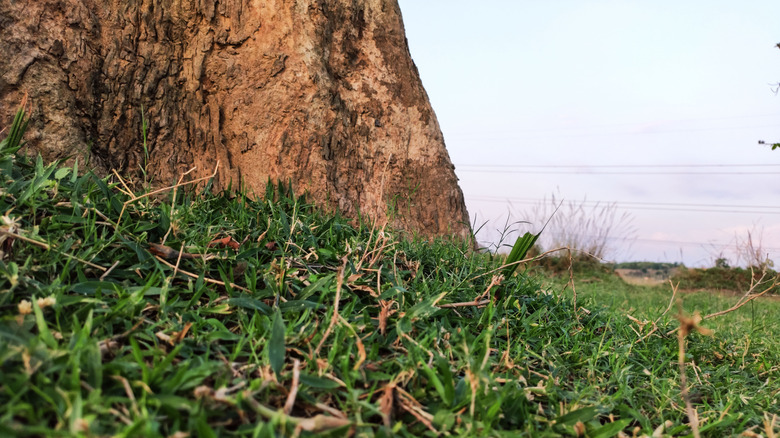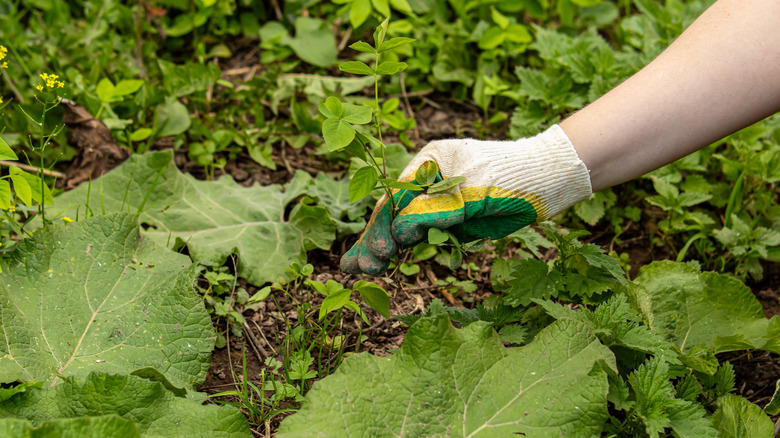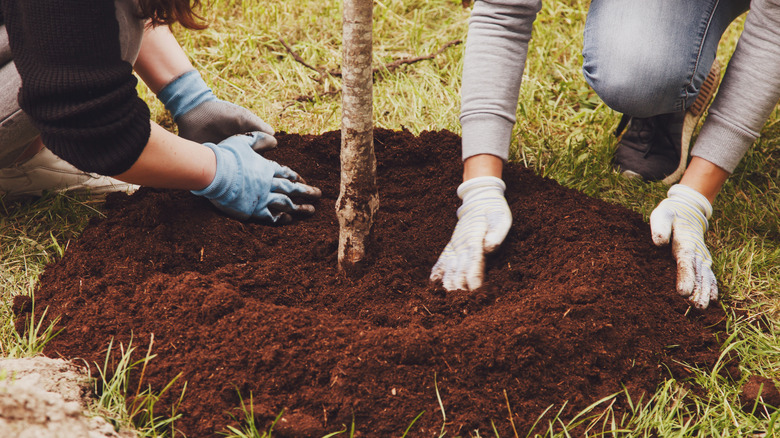Lawn Care Tips To Prevent Weeds From Growing Under Trees
Weeds can be a gardener's worst enemy, especially if you live in an area where toxic weeds run rampant and are hard to scare off. Even after following tips for getting weeds out of your garden, you might find certain species popping back up, threatening the health and aesthetic of your lawn. This can even threaten seemingly permanent features like trees, so it's crucial to use methods to keep tree roots clear of weeds. We talked with Bryan Clayton, CEO of GreenPal and a lifelong lawn care expert, about the risks weeds pose to trees and to get his expert-approved tips. "The best way to prevent weeds is a combination of good prep, the right materials, and consistent maintenance," he said.
But first: Why is it even important to care about weed presence at the base of your trees? "Weeds compete with trees for water, nutrients, and space," Clayton said in an exclusive interview with House Digest. "Over time, they can weaken the tree, especially young ones. Keeping the area weed-free helps your tree grow stronger and healthier, while also improving the overall look of your yard." Fortunately, there are plenty of simple ways to do this and common mistakes to avoid to ensure your trees live long and healthy lives.
Tips for preventing weeds under trees
Among the hacks for this common issue, there's an ingenuous planting technique that will make weeds a thing of the past for your tree roots. "One of the best ways to combat weeds is to plant a ground cover," Bryan Clayton exclusively told House Digest. Clayton said you can find ground cover plants that "grow well in shady areas under tree canopies, help stabilize soil to prevent erosion, and naturally crowd out weeds by taking up space and nutrients." The less space that weeds have to take up, the less they'll be able to spread.
Similarly, using mulch around trees will prevent weeds from getting necessary resources. "Mulch not only looks good but also helps prevent weeds by blocking sunlight from reaching the soil," Clayton said. Plus, you can mix things into the mulch that double up the weed-killing properties. "Adding a pre-emergent herbicide every February with the mulch will stop weed seeds from germinating."
Another route to go is by placing down landscaping fabric, an easy and affordable gardening aid. According to Clayton, gardeners should "install landscaping fabric around the base of the tree before applying mulch." The effects will minimize weed growth. "The fabric acts as a barrier to weeds while allowing water to flow through to the tree roots," he said. If you want to add more aesthetically pleasing garden features atop your landscaping fabric, Clayton recommends river rocks. "For a low-maintenance option, lay down weed fabric and cover it with river rock. It suppresses weeds, allows water to reach the roots, and gives the area a polished look," he said.
Mistakes to avoid with weed care
Like all good lawn care projects, it's crucial to listen to expert advice before making mistakes that could cost you time, money, and could lead to weed growth despite all of your best efforts. Bryan Clayton noted in an exclusive interview with House Digest that one major mistake he sees gardeners make is skipping the ground preparation steps. "People often throw mulch or rock directly on the ground without prepping it," he said. "Without weed fabric or a pre-emergent, the weeds will just grow right back through." Avoid future issues by knowing the reason why your weed fabric isn't working and how to fix it.
Clayton noted that it's important to ensure you use fabric and avoid plastic. "Plastic is a big mistake — it blocks water and air from reaching the tree's roots, which can harm the tree over time," he said. Because you don't want your weed elimination tactics to end up eliminating plants you do want to keep, you should consider this one of the most important tips for your project.
Once the groundwork has been laid, you also need to plan for regular maintenance of the area. "Even with all the right steps, some weeds will still pop up," Clayton said. "Regularly checking the area and pulling stray weeds will keep the problem from getting out of hand."


